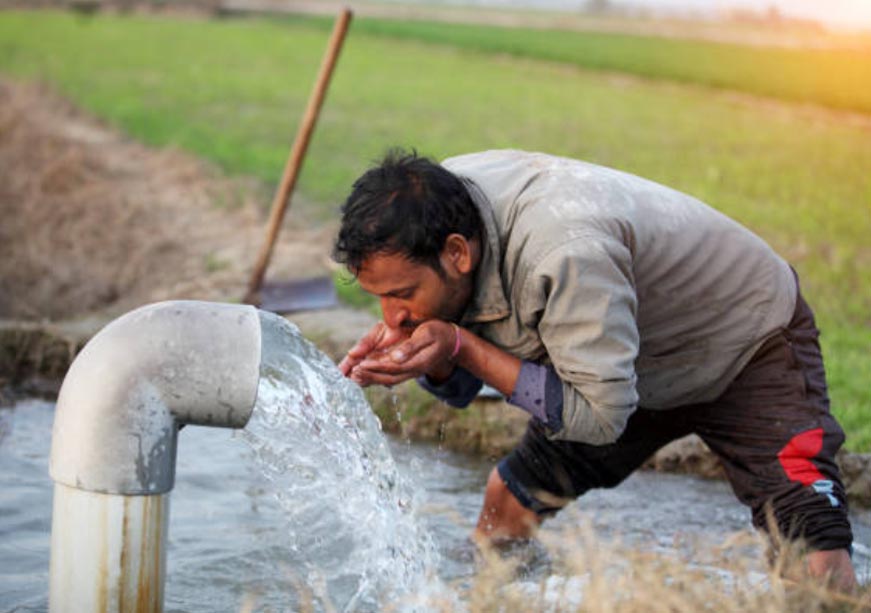-
CENTRES
Progammes & Centres
Location
With climate change straining shared water reserves, India’s cities and farms are on a collision course unless conservation, reuse, and technology drive urgent reforms.

Image Source: Getty Images
This article is a part of the essay series: World Water Week 2025
There is nothing more traumatic for a city than to discover that it has run out of water. Households become dysfunctional; industries come to a grinding halt, and services shut their doors. The city administration, citizens, and establishments stop their normal activities and get glued to one single task – how to find some water to survive. Given this scenario, it should not be difficult to convince people that there is no life without water. One of the warnings emanating from climate change is that while extreme weather events may bring sudden torrential rains and floods to a city, droughts and prolonged water scarcity are equally potent possibilities due to irregular monsoon patterns produced by climate change. Furthermore, higher temperatures and reduced precipitation levels are also likely to result in slower replenishment rates of underground water resources and reduced availability of surface water. According to a 2020 report of the World Wide Fund (WWF) Water Risk Filter, 30 Indian cities could face water-related risks induced by climate change, which could alter the distribution and quality of India’s water resources. These include megacities such as Delhi, Mumbai, Bengaluru, and Kolkata and huge metros such as Ahmedabad, Pune, Surat, Jaipur, and Indore. The risks comprise torrential rains, changed spatial and temporal distribution of rainfall, higher runoff generation and low groundwater recharge.
The Ministry of Housing and Urban Affairs suggests a benchmark of 135 litres per capita per day (lpcd) for urban water supply in India. However, it is possible to reduce this amount to around 100 lpcd, especially by reducing water allocated for flushing and miscellaneous uses.
Several cities in India source water from storage dams. These water reservoirs are designed to simultaneously serve agricultural requirements. This sets up repeated conflicts between the city administrations and the state irrigation departments. With expanding urbanisation, urban populations swell, water demand for homes and businesses is driven up, and the quantum of water allocated to cities by the state falls short of the requirements. City administrations, therefore, have to periodically seek an upward revision of their annual water quota. However, unless there is additional capacity created to hold supplementary water, states often meet the additional urban demand by inescapably reducing water for agriculture.
Despite most states assigning drinking water as the top priority for usage, agriculture has almost equal primacy for life. Hence, agricultural output must be protected by ensuring the adequacy of water supply to agriculture at the right time and in the right quantity. Any compromise with such a water supply has huge consequences for agricultural production, rural livelihoods, and the country’s food security. This situation naturally leads to a challenge, resulting in spats between city administrations and the state irrigation departments.
A recent example was witnessed in Pune, where in February 2025, the Pune Municipal Corporation (PMC) and the state Water Resources Department (WRD) were embroiled in a dispute over water. The WRD alleged that the PMC was drawing water in excess of the quota allocated to it, adversely affecting irrigation downstream. Additionally, the PMC was allegedly releasing untreated sewage water that caused pollution problems, both to agriculture and drinking water in the downstream villages. The PMC contested the allegations levelled by the WRD. This prompted a review meeting organised by the state WRD minister, which resulted in the establishment of a task force comprising the Pune Municipal Commissioner and the Executive Director of the Krishna Valley Development Corporation, to suggest corrective measures for preventing water leakage, enhancing sewage treatment, and the reuse of treated water for gardens and non-potable purposes.
It is a well-researched fact that many Indian cities have high systemic water leakage, estimated at 20 to 35 percent of the total flow, sometimes higher. Through a comprehensive attempt at leak detection and repair enabled by technology (sensors, pipe replacement, and ward-wise metering), it is possible to bring down such losses to 3 to 5 percent of the total flow.
The case of Pune is not an isolated incident. Latur, Solapur, and Dharashiv, for instance, lie in the rain-shadow region of the Western Ghats and draw water from the same sources that were primarily created for crop irrigation. The state and these cities face a similar predicament, especially in times of deficient rainfall when water storage in the dams is reduced.
In the context of the effects of climate change on water resources, the realisation ought to quickly dawn on all decision-makers that we all are likely to face life-threatening challenges. Cities, therefore, under no circumstance, should consume more than what is nationally prescribed. The Ministry of Housing and Urban Affairs suggests a benchmark of 135 litres per capita per day (lpcd) for urban water supply in India. This includes 7 litres for drinking, 20 for bathing, 40 for washing clothes and utensils, 45 for toilet flushing, and 23 for miscellaneous activities. However, it is possible to reduce this amount to around 100 lpcd, especially by reducing water allocated for flushing and miscellaneous uses.
It is also a well-researched fact that many Indian cities have high systemic water leakage, estimated at 20 to 35 percent of the total flow, sometimes higher. The GOI’s service level benchmarks (SLB) put the acceptable non-revenue water (NRW) level at 20 percent. However, through a comprehensive attempt at leak detection and repair enabled by technology (sensors, pipe replacement, and ward-wise metering), it is possible to bring down such losses to 3 to 5 percent of the total flow and recover the costs in about a year.
The non-treatment of urban sewage water is a national emergency and needs to be taken up on a national scale. Maximising permeability of the city ground surface is almost equally critical, both for managing floods and for allowing greater recharge of groundwater.
Furthermore, cities must place sewage water treatment very high on their priority list. On average, around 80 percent of the water pumped into a city flows out as sewage water. Alarmingly, around 80 percent of this sewage water finds its way untreated into water streams, causing significant pollution and health hazards for those living downstream. If this water can be treated to an extent that is usable in agriculture, the conflict between cities and agriculture could be comprehensively resolved. Hence, it becomes incumbent on the city to treat this sewage water. Unfortunately, no city in the country has the capacity to treat all of its sewage water. The better performing ones, such as Pune, Chennai, Surat and Gurgaon, treat around half of their sewage water. The majority of India’s cities have no sewage network worth the name. The non-treatment of urban sewage water is a national emergency and needs to be taken up on a national scale. Maximising permeability of the city ground surface is almost equally critical, both for managing floods and for allowing greater recharge of groundwater. Today, there is a careless propensity to build concrete pathways in gardens and concretise permeable surfaces. This is disastrous, and the trend ought to be nationally reversed.
Further, for managing their water demand, cities should mandatorily adopt water metering for regulating water consumption in households and business establishments and impose an escalating water tariff that charges higher rates for higher usage. Similarly, more heed needs to be paid to the use of water-efficient fixtures.
For the long-term mitigation of climate change impacts, urban water service providers must seek to diversify water sources, since single-source reliance is likely to become highly risky. The diversification methods could include tapping groundwater aquifers, inter-basin water transfer, rainwater harvesting, and desalination.
Nature-based solutions for urban wetlands, reforestation, and river restoration should be adopted. This would allow optimising all-round paybacks for the city and spawn a wider catchment area without affecting the sustainability of vital ecosystems.
There are urgent changes to be made on the agriculture front as well. The canals that transport water to the agricultural fields often incur massive seepage losses. These are estimated to be between 15 to 20 percent in conveyance, apart from contributing to waterlogging of lands and salt and alkali concentration in soils. In the age of climate change, such losses are impermissible. It is incumbent on the state WRDs to prevent this through proper, impermeable lining. Similarly, certain practices in agriculture, such as flow irrigation, need to be replaced by the more efficient drip and sprinkler systems that help minimise water use without impacting productivity.
Finally, climate change makes it imperative that every entity involved in the management and provision of water adopt an integrated water management system that encompasses all components of the water cycle — surface water, groundwater, rainwater, storm water and wastewater. Further, nature-based solutions for urban wetlands, reforestation, and river restoration should be adopted. This would allow optimising all-round paybacks for the city and spawn a wider catchment area without affecting the sustainability of vital ecosystems.
However, such re-engineering of water management raises the critical question of funding. Cities would require substantial assistance from the states and the central government to undertake new infrastructural projects. Given the twin pressures of climate change and weak municipal finances — alongside the rising economic significance of cities — the Government of India and the states have little choice but to step in and provide the necessary assistance to the cities.
Ramanath Jha is a Distinguished Fellow at the Observer Research Foundation.
The views expressed above belong to the author(s). ORF research and analyses now available on Telegram! Click here to access our curated content — blogs, longforms and interviews.

Dr. Ramanath Jha is Distinguished Fellow at Observer Research Foundation, Mumbai. He works on urbanisation — urban sustainability, urban governance and urban planning. Dr. Jha belongs ...
Read More +